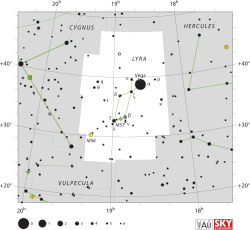Zeta1 Lyrae – Wikipedia
| Zeta1 Lyrae (ζ1) | |
 | |
| Observationsdata Epok: J2000.0 | |
|---|---|
| Stjärnbild | Lyran |
| Rektascension | 18t 44m 46,35735s[1] |
| Deklination | 37° 36′ 18,4171″[1] |
| Skenbar magnitud () | 4,37[2] |
| Stjärntyp | |
| Spektraltyp | kA5hF0mF2[3] |
| U–B | +0,17[2] |
| B–V | +0,18[2] |
| Astrometri | |
| Egenrörelse (µ) | RA: +29,04[1] mas/år Dek.: +27,03[1] mas/år |
| Parallax () | 20,89 ± 0,17[1] |
| Avstånd | 156 ± 1 lå (47,9 ± 0,4 pc) |
| Detaljer | |
| Massa | 2,36[4] M☉ |
| Radie | 2,5[5] R☉ |
| Luminositet | 31[6] L☉ |
| Temperatur | 7 914 ± 112[7] K |
| Metallicitet | 0,38 ± 0,06[7] |
| Vinkelhastighet | 47 [8] km/s |
| Ålder | 500[4] miljoner år |
| Andra beteckningar | |
| ^ Lyr, 6 Lyrae, BD + 37° 3222, HD 173648, HIP 91971, HR 7056, SAO 67321.[9] | |
Zeta1 Lyrae (ζ1 Lyrae, förkortat Zeta1 Lyr, ζ1 Lyr) som är stjärnans Bayerbeteckning, är en dubbelstjärna belägen i den mellersta delen av stjärnbilden Lyran. Den har en skenbar magnitud på 4,37[2] och är synlig för blotta ögat. Baserat på parallaxmätning inom Hipparcosuppdraget på ca 20,9 mas,[1] beräknas den befinna sig på ett avstånd av ca 156 ljusår (48 parsek) från solen.
Egenskaper
[redigera | redigera wikitext]Primärstjärnan Zeta1 Lyrae A är en blå Am-stjärna av spektralklass kA5hF0mF2. Den komplexa notationen anger att spektraltypen, bestämd enbart från spektrumets Calcium K-linjer skulle vara A5, spektraltypen bestämd från andra metalliska linjer skulle vara F2 och typen bestämd från vätelinjer skulle vara F0[3]. Den har en massa som är 2,4[4] gånger större än solens och en radie som är 2,5 gånger större än solens radie.[5] Den utsänder från dess fotosfär 31[6] gånger mer energi än solen vid en effektiv temperatur på ca 7 900 K[7]. Positionen för stjärnan är förknippad med en röntgenkälla med en ljusstyrka på 571,6 × 1020 W.[10]
Zeta1 Lyrae är en ensidig spektroskopisk dubbelstjärna med en omloppsperiod på 4,3 dygn och ett nästan cirkulärt omlopp med en excentricitet på 0,01.[11] Den verkar vara något variabel, med en frekvens på 0,65256 cykler per dygn och en amplitud på 0,0032 i magnitud.[12]
Källor
[redigera | redigera wikitext]- Den här artikeln är helt eller delvis baserad på material från engelskspråkiga Wikipedia, tidigare version.
Referenser
[redigera | redigera wikitext]- ^ [a b c d e f] van Leeuwen, F. (2007), "Validation of the new Hipparcos reduction", Astronomy and Astrophysics, 474 (2): 653–664, Bibcode:2007A&A...474..653V, arXiv:0708.1752 Freely accessible, doi:10.1051/0004-6361:20078357.
- ^ [a b c d] Mermilliod, J.-C. (1986), "Compilation of Eggen's UBV data, transformed to UBV (unpublished)", Catalogue of Eggen's UBV data, SIMBAD, Bibcode:1986EgUBV........0M.
- ^ [a b] [Abt, Helmut A.; Morrell, Nidia I. (1995). "The Relation between Rotational Velocities and Spectral Peculiarities among A-Type Stars". Astrophysical Journal Supplement v.99. 99: 135. Bibcode:1995ApJS...99..135A. doi:10.1086/192182.3]
- ^ [a b c] De Rosa, R. J.; et al. (2013), "The VAST Survey - III. The multiplicity of A-type stars within 75 pc", Monthly Notices of the Royal Astronomical Society, 437 (2): 1216, Bibcode:2014MNRAS.437.1216D, arXiv:1311.7141 Freely accessible, doi:10.1093/mnras/stt1932.
- ^ [a b] Pasinetti Fracassini, L. E.; Pastori, L.; Covino, S.; Pozzi, A. (February 2001), "Catalogue of Apparent Diameters and Absolute Radii of Stars (CADARS)", Astronomy and Astrophysics (3rd ed.), 367 (2): 521–524, Bibcode:2001A&A...367..521P, arXiv:astro-ph/0012289 Freely accessible, doi:10.1051/0004-6361:20000451.
- ^ [a b] McDonald, I.; et al. (2012). "Fundamental Parameters and Infrared Excesses of Hipparcos Stars". Monthly Notices of the Royal Astronomical Society. 427 (1): 343–57. Bibcode:2012MNRAS.427..343M. arXiv:1208.2037 Freely accessible. doi:10.1111/j.1365-2966.2012.21873.x.
- ^ [a b c] Prugniel, Ph.; et al. (2011), "The atmospheric parameters and spectral interpolator for the MILES stars", Astronomy & Astrophysics, 531: A165, Bibcode:2011A&A...531A.165P, arXiv:1104.4952 Freely accessible, doi:10.1051/0004-6361/201116769.
- ^ Royer, F.; et al. (October 2002), "Rotational velocities of A-type stars in the northern hemisphere. II. Measurement of v sin i", Astronomy and Astrophysics, 393 (3): 897−911, Bibcode:2002A&A...393..897R, arXiv:astro-ph/0205255 Freely accessible, doi:10.1051/0004-6361:20020943.
- ^ "* zet01 Lyr". SIMBAD. Centre de données astronomiques de Strasbourg. Hämtad 2017-03-17.
- ^ Schröder, C.; Schmitt, J. H. M. M. (November 2007), "X-ray emission from A-type stars", Astronomy and Astrophysics, 475 (2): 677−684, Bibcode:2007A&A...475..677S, doi:10.1051/0004-6361:20077429.
- ^ ourbaix, D.; Tokovinin, A. A.; Batten, A. H.; Fekel, F. C.; Hartkopf, W. I.; et al. (2004), "SB9: The ninth catalogue of spectroscopic binary orbits", Astronomy & Astrophysics, 424 (2): 727, Bibcode:2004A&A...424..727P, arXiv:astro-ph/0406573 Freely accessible, doi:10.1051/0004-6361:20041213.
- ^ Koen, Chris; Eyer, Laurent (2002), "New periodic variables from the Hipparcos epoch photometry", Monthly Notices of the Royal Astronomical Society, 331: 45, Bibcode:2002MNRAS.331...45K, arXiv:astro-ph/0112194 Freely accessible, doi:10.1046/j.1365-8711.2002.05150.x.


 French
French Deutsch
Deutsch

